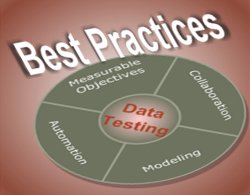Data Integrity
Testing Best Practices
The term “Best
Practices” defines a technique that reliably leads to a proven result. The best
practice for data testing is built on a foundation with four corners that are
the keys to successful data testing. These best practices focus on objectives,
cooperation, clarity and efficiencies. This overcomes ineffective and
error-prone processes that really do not validate data integrity. Through these
four corners in the data testing best practices, there are measurable quality
results with provable data integrity.
The Four
Corners of Data Testing

1. Measurable
Quality Objectives
Proving data integrity is
troublesome without specific objectives. It will cause the team to focus on the
wrong needs and fall short of accurate integrity validation. Create measurable data
quality goals supported by objectives that focus on attributes of
accuracy, completeness, validity and consistency.
Use these
attributes to define one or more attainable objectives. Describe how objectives
are to be achieved and in what time frame. Be sure to perform a reality check
ensuring the goals are attainable and support the process of data integrity.
2.
Collaboration
Testing data is a matter of validating deliverables that describe the proper use
of information, correctness of data analysis, reliability of integration
mechanisms and accuracy of transformation rules. Collaboration points are used
throughout the integration and design efforts to capture these deliverables,
enabling the test team to effectively test integration.
Data integration
efforts are typically problematic for test teams as testable requirements are
thin while favoring other deliverables like data analysis, technical
specifications and transformation rules. Inject enough touch points with the
analysis and development efforts to ensure test planning and design encapsulates
these deliverables that are at the heart of the integration.
3. Modeling
Following data through the subsystems and transformation paths is the only true
way to validate and test data. Abstracting the integration subsystems and
transformation paths into models is the best way to follow the data. At the same
time, it creates
a top-down analytical view that simplifies a complex system.
Simply, it helps eliminate ambiguities of text.
Models are used
to represent the system as the designers conceptualize their work. This is
useful for ensuring proper test coverage and critical junctures in the design.
Models are also excellent for capturing the test workflow making it easer for
the test team to divide and implement the work.
4. Automation
Automating data testing reduces errors and provides a strategy for ongoing
integrity validation. Through automation, the team is able to develop repeatable
tests that can automatically analyze and evaluate the results of data
integration. Automation also removes the tedious tasks of test setup and
execution. Because automation allows the team to concentrate on test design
rather than execution, the team is able to increase test coverage while digging deeper
into the validity checks.
Manual data
testing is no alternative to automation. Manual data testing is resource
intensive, tedious and prone to errors. It cannot be repeated and may cost
several times more than application testing. Automation is vital to ongoing data
validation because data can be changed in dozens of places by any person or
system that touches it even after integration development. |